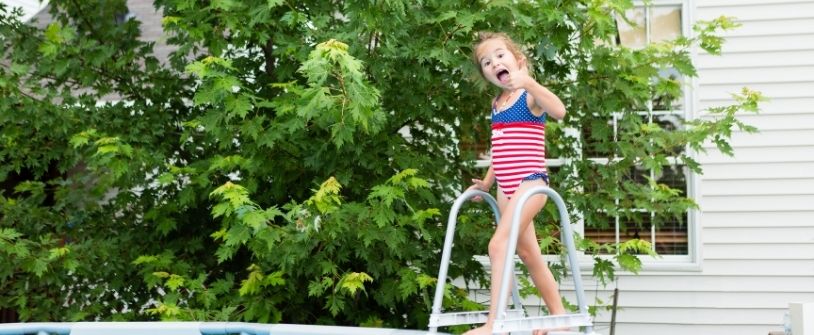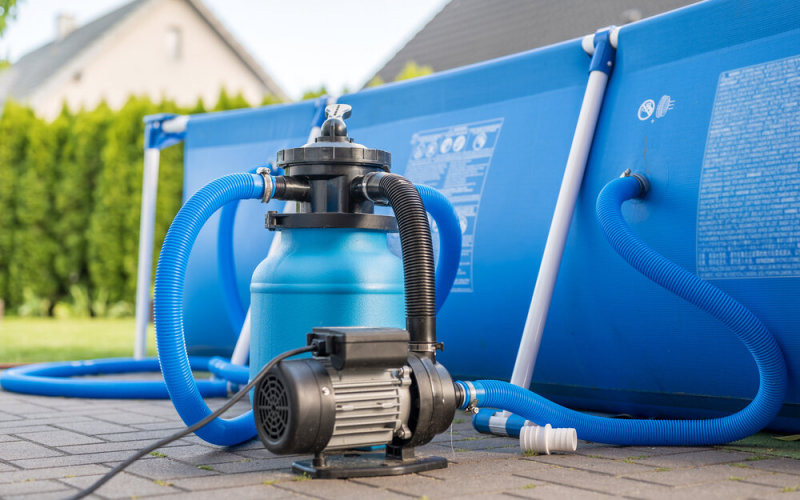Are your pool jets not working as they should? This article will guide you through troubleshooting common issues that can hinder the performance of pool jets.
From low pressure caused by factors such as low water levels and clogs, to high pressure due to a dirty filter or debris in the pool, we will provide step-by-step instructions to help you rectify these problems.
By understanding and addressing these issues, you can ensure an enjoyable and refreshing swimming experience.
Key Takeaways
- Low pressure in the pool jet system can be caused by low water level, air leaks, pump malfunction, and clogs.
- Air leaks in the system can result in weak and ineffective return jets, and can be caused by cracked lines, damaged O-rings, faulty valves, and loose drain plugs.
- Pump malfunction, such as pump priming issues and impeller clogs, can lead to weak return jets.
- High pressure in the pool jet system can also cause weak return jets and may be caused by a dirty filter and debris in the pool. Regular cleaning of the filter and maintaining a pool-cleaning routine is important to prevent high pressure issues.
Low Pressure in the Pool Jet System
Low pressure in the pool jet system is a common issue that can affect the efficiency and functionality of the jets. Pool jets rely on the filter, pump, and connecting components to circulate water effectively. When the pressure is low, the jets may not deliver the desired water flow and force. Troubleshooting low pressure in the pool jet system is important for maintaining proper pool water circulation.
There are several potential causes of low pressure in the pool jet system. One common cause is a low water level in the pool. When the water level is too low, air can enter the system, slowing down water flow and potentially damaging the pump. To solve this issue, it is recommended to add more water to the pool until it reaches the midpoint of the skimmer opening.
Another cause of low pressure is air leaks in the system. A complete seal in all parts of the system is necessary for proper water circulation. Common components that can cause air leaks include cracked lines, damaged O-rings, faulty valves, and loose drain plugs. If there is a low pressure reading on the pressure gauge and the presence of bubbles, it may indicate an air leak. In this case, it is advisable to accurately diagnose the air leak and call a pool technician for repair.
Additionally, pump malfunction can result in weak return jets. Pump priming issues and impeller clogs are common reasons for pump malfunction. To address this, it is recommended to open the pump and clear debris from the impeller. Priming issues can be resolved by filling the strainer cavity with water.
Clogs in the system can also cause low pressure in the pool jet system. Debris in the pool can lead to clogs in the pool lines, preventing water from entering the pool pump. Using a drain cleaning bladder can effectively remove the clog in the pool pipes.
Air Leaks in the System
An air leak in the pool jet system can result in weak and ineffective return jets. It is important to address air leaks promptly to ensure proper water circulation and prevent further damage to the system.
Here are some common causes of air leaks in the system and their solutions:
- Cracked lines: Inspect the pool lines for any cracks or damage. Replace any cracked lines to restore the system's integrity.
- Damaged O-rings: O-rings are responsible for creating a tight seal in various components of the pool jet system. If you notice any damaged or worn-out O-rings, replace them to eliminate air leaks.
- Faulty valves: Faulty valves can cause air to enter the system. Check all valves for proper functionality and replace any that are not working correctly.
- Loose drain plugs: Ensure that all drain plugs are tightly secured. Loose drain plugs can allow air to enter the system, leading to air leaks.
To accurately diagnose and repair air leaks, it is recommended to call a pool technician. They have the expertise and equipment to identify the exact location of the air leak and perform the necessary repairs. Additionally, they can inspect the entire pool jet system for any other potential issues that may be contributing to the weak return jets.
By addressing air leaks promptly and effectively, you can ensure that your pool jets are working optimally. Regular maintenance and inspection of the pool jet system can help prevent air leaks and other pool jet problems.
If you encounter any issues with your pool jets, it is always best to seek professional assistance for proper pool jet repair.
Pump Malfunction
When addressing pool jet issues, it is important to consider the possibility of a pump malfunction. The pool pump plays a crucial role in maintaining proper water circulation, which is essential for the efficient functioning of the pool jets. A malfunctioning pump can result in weak or non-functional return jets, leading to pool water circulation problems.
There are several common reasons for pump malfunction. One of the main culprits is pump priming issues. If the pump fails to prime properly, it may not be able to draw water in and push it through the pool jets effectively. Another common issue is impeller clogs. Debris such as leaves, twigs, or small objects can get stuck in the impeller, hindering its ability to move water efficiently.
To troubleshoot a pump malfunction, it is necessary to open the pump and inspect the impeller for any clogs. If clogs are present, they should be cleared to allow for proper water flow. Additionally, addressing pump priming issues can help resolve any circulation problems. This can be done by filling the strainer cavity with water before turning on the pump, ensuring that it has enough water to prime properly.
Regular pump maintenance is crucial to prevent pump malfunctions. This includes cleaning the pump regularly, checking for any signs of wear or damage, and addressing any issues promptly. By following these pool jet maintenance tips, and being proactive in pump maintenance, pool owners can ensure that their pool water circulation remains optimal, and their pool jets continue to work effectively.
Clogs in the System
Debris present in the pool can lead to clogs within the pool lines, impeding water flow and causing low pressure in the pool jets. When clogs occur in the system, it is important to address them promptly to ensure proper pool water flow and maintain the efficiency of the pool jets.
Here are some steps to troubleshoot clogs in the system:
- Identify the symptoms: Low pressure in the pool jets is a common sign of clogs in the system. If you notice that the jets are not producing the usual forceful flow of water, it may indicate a clog.
- Locate the clog: Start by inspecting the pool skimmer and pump basket for any visible debris or blockages. If the clog is not easily visible, it may be deeper within the pool lines.
- Clear the clog: One effective method to remove clogs in the pool pipes is by using a drain cleaning bladder. This device attaches to a garden hose and is inserted into the pool lines to flush out any debris causing the clog.
Regular swimming pool maintenance is crucial to prevent clogs in the system. Here are some additional tips to minimize the occurrence of clogs and ensure optimal pool water flow:
- Skim the pool regularly to remove leaves, twigs, and other debris that can accumulate and potentially cause clogs.
- Use a pool cover when the pool is not in use to prevent debris from entering the water.
- Clean the pool filter regularly to prevent build-up and maintain proper water circulation.
- Consider using a pool vacuum or automatic pool cleaner to remove dirt and debris from the pool floor and walls.
High Pressure in the Pool Jet System
High pressure in the pool jet system can lead to weak return jets and decreased effectiveness.
Maintaining the filter is crucial to prevent high pressure issues, as a dirty filter can restrict water flow.
Additionally, regularly removing debris from the pool and treating it for algae can help prevent high pressure problems.
Filter Maintenance Tips
Regular filter maintenance is essential for maintaining optimal performance and preventing high pressure issues in the pool jet system. Here are some filter maintenance tips to keep your pool jets working efficiently:
- Clean the filter regularly: A dirty filter can restrict water flow and lead to high pressure. Follow the manufacturer's guidelines to clean the filter regularly and remove any debris or contaminants.
- Treat the pool for algae if necessary: Algae growth can clog the filter and increase pressure in the system. Use appropriate pool chemicals to prevent algae growth and maintain a clean pool.
- Maintain ongoing pool-cleaning routine: Regularly skimming the surface, vacuuming the pool, and removing debris can prevent clogs and reduce the strain on the filter. This helps to maintain normal pressure in the pool jet system.
By following these filter maintenance tips, you can ensure that your pool jets continue to function properly and provide a refreshing and enjoyable swimming experience.
For more pool maintenance tips, refer to our comprehensive pool jet guide.
Debris Removal Techniques
Effective maintenance is crucial for addressing high pressure issues in the pool jet system and ensuring proper debris removal. High pressure can lead to weak return jets, reducing the effectiveness of the pool water treatment.
One common cause of high pressure is a dirty filter. A dirty filter restricts water flow, causing the pressure to build up. Regularly cleaning the filter is essential to prevent this issue.
Additionally, debris in the pool can also contribute to high pressure. Maintaining an ongoing pool-cleaning routine and treating the pool for algae if necessary can help prevent debris buildup.
Preventing High Pressure Issues
To prevent high pressure issues in the pool jet system, it is important to regularly maintain and clean the pool filter in order to ensure optimal water flow and prevent pressure buildup.
Here are some steps to prevent high pressure in the pool jet system:
- Regularly maintain and clean the pool filter to remove debris and prevent clogs.
- Keep the pool water balanced and chemically treated to prevent the growth of algae and other contaminants that can clog the filter.
- Check the pool pump regularly for any signs of malfunction and address any issues promptly to prevent pressure buildup.
Water Level Issues
Insufficient water levels can significantly impact the functionality of pool jets, hindering their ability to circulate water effectively. Pool jets rely on a proper water level to operate optimally. When the water level is too low, it can cause air to enter the system, leading to reduced water flow and potential damage to the pump. To remedy this, it is important to add more water to the pool until it reaches the midpoint of the skimmer opening.
Air leaks in the pool jet system can also contribute to weak and ineffective return jets. A complete seal in all parts of the system is necessary for proper water circulation. Common components that can cause air leaks include cracked lines, damaged O-rings, faulty valves, and loose drain plugs. If there is a low pressure reading on the pressure gauge and the presence of bubbles, it indicates an air leak. In such cases, it is recommended to accurately diagnose the air leak and call a pool technician for repair.
Furthermore, a malfunctioning pool pump can result in weak return jets. Pump priming issues and impeller clogs are common reasons for pump malfunction. To address this, it is important to open the pump and clear any debris from the impeller. Additionally, priming issues can be resolved by filling the strainer cavity with water.
Clogs in the pool lines can also lead to low pressure in the jets. Debris in the pool can cause these clogs, preventing water from entering the pool pump. To resolve this issue, a drain cleaning bladder can be used to remove the clog in the pool pipes.
Lastly, high pressure issues can also cause weak return jets. Dirty filters and debris in the pool are common causes of high pressure. A dirty filter reduces the effectiveness of the jets. To rectify this, it is important to clean the filter regularly, treat the pool for algae if necessary, and maintain an ongoing pool-cleaning routine.
Cracked Lines and Damaged O-Rings
When dealing with pool jet issues, it is important to address the potential problem of cracked lines and damaged O-rings. Cracked lines can lead to leaks and loss of pressure in the system, while damaged O-rings can result in air leaks and ineffective water circulation.
To resolve these issues, it is necessary to repair any cracked lines and replace damaged O-rings to ensure a complete seal and proper functioning of the pool jet system.
Additionally, taking preventative measures, such as regular inspections and maintenance, can help prevent future damage to the lines and O-rings.
Repairing Cracked Lines
One potential cause of low pressure and weak return jets in the pool jet system could be cracked lines and damaged O-rings. When these components become compromised, water can leak out of the system, resulting in reduced pressure and ineffective jet performance.
To repair cracked lines and damaged O-rings, follow these steps:
- Identify the location of the cracks or damage in the lines or O-rings.
- Use a PVC pipe cutter or a hacksaw to cut out the damaged section of the line.
- Replace the cracked line with a new piece of PVC pipe, ensuring a tight and secure connection.
- For damaged O-rings, remove the old O-ring and clean the groove it sits in.
- Install a new O-ring of the correct size and material, making sure it is properly seated.
By repairing cracked lines and damaged O-rings, you can restore proper water flow and pressure in the pool jet system.
In the next section, we will discuss the process of replacing damaged O-rings entirely.
Replacing Damaged O-Rings
To ensure optimal performance and prevent water leakage in the pool jet system, it is essential to replace damaged O-rings and address cracked lines promptly. O-rings are essential components that create a watertight seal in the pool jet system. Over time, O-rings can become worn, cracked, or damaged, leading to leaks and reduced water pressure.
When inspecting the system, check for any signs of O-ring damage, such as visible cracks or deterioration. If damaged O-rings are found, they should be replaced immediately to restore the proper function of the pool jet system. It is important to use the correct size and type of O-ring when replacing them to ensure a secure seal.
Regular maintenance and inspection of O-rings can help prolong their lifespan and prevent potential issues in the pool jet system.
Preventing Future Damage
Regular maintenance and proper handling are essential in preventing future damage, such as cracked lines and damaged O-rings, in the pool jet system. To prevent future damage, consider the following steps:
- Conduct regular inspections:
- Check for any signs of cracks or damage in the pool lines and O-rings.
- Look for any loose connections or fittings that may need tightening.
- Inspect the pool jet system for any leaks or potential weak points.
- Perform routine maintenance:
- Clean the pool filter regularly to prevent debris buildup and clogs.
- Lubricate O-rings and other moving parts to ensure smooth operation.
- Keep the pool water balanced and properly treated to avoid corrosion and damage.
- Handle with care:
- Avoid excessive force when operating valves or adjusting pool jet settings.
- Use caution when cleaning or servicing the pool jet system to prevent accidental damage.
- Follow manufacturer's guidelines for proper installation and maintenance procedures.
Faulty Valves and Loose Drain Plugs
Faulty valves and loose drain plugs can disrupt the proper functioning of pool jets, leading to reduced water flow and ineffective circulation. These components are vital for maintaining the integrity of the pool jet system and ensuring that the water is properly circulated. Here are the common issues related to faulty valves and loose drain plugs:
| Common Issues | Possible Causes |
|---|---|
| Pool jets not working | Faulty valves or loose drain plugs |
| Reduced water flow | Loose drain plugs or partially closed valves |
| Ineffective circulation | Faulty valves or restricted water flow |
When valves become faulty or drain plugs become loose, it can cause a disruption in the water flow, resulting in reduced circulation and ineffective pool jets. This can be a frustrating issue for pool owners as it can affect the overall enjoyment of the pool. To resolve these issues, it is important to accurately diagnose the problem and take appropriate action. Tightening loose drain plugs and inspecting valves for any signs of damage or malfunction can help to restore proper water flow and circulation in the pool jets.
Addressing faulty valves and loose drain plugs is crucial in troubleshooting pool jet issues. By ensuring that these components are functioning properly, pool owners can prevent reduced water flow and ineffective circulation. Once these issues are resolved, it is important to move on to the next section and address any potential pump priming issues to ensure the pool jets are working optimally.
Pump Priming Issues
When pool jets are not working properly, one possible cause could be pump priming issues. Priming issues occur when there is not enough water in the pump's strainer cavity to create the necessary suction for proper operation.
This can be addressed by filling the strainer cavity with water to ensure proper priming and optimal performance of the pool jets.
Priming Water Level Required
To ensure proper functioning of the pool jets, maintaining the appropriate water level for priming the pump is crucial.
Here are some key points to consider regarding the priming water level required:
- Insufficient water level can hinder the pump from functioning properly and result in weak or non-existent pool jets.
- The water level should be maintained at the midpoint of the skimmer opening to ensure adequate priming.
- If the water level is too low, air can enter the system, causing a decrease in water flow and potentially damaging the pump.
- To address low water levels, add more water to the pool until it reaches the recommended level.
- Regularly monitor and maintain the water level to ensure optimal performance of the pool jets.
Priming Issues Troubleshooting Steps
A pump priming issue can hinder the proper functioning of the pool jets, but there are troubleshooting steps that can help address this problem.
One common cause of pump priming issues is air trapped in the system. To resolve this, start by turning off the pump and opening the air release valve on the filter. This will release any trapped air.
Next, ensure that the pool skimmer and pump strainer baskets are free from debris. If the issue persists, check the pump lid gasket for any damage or wear, as this can also cause air leaks.
Additionally, make sure that the pump is properly primed by filling the strainer basket with water before starting the pump.
If these steps do not resolve the issue, it is advisable to seek assistance from a pool technician.
Impeller Clogs
Impeller clogs can significantly impair the functionality of pool jets, causing a decrease in water flow and a reduction in overall performance. When the impeller, which is responsible for pushing water through the jets, becomes clogged, it restricts the flow and can lead to issues with the pool's water circulation system.
Here are some important points to consider when troubleshooting impeller clogs:
- Debris Buildup: Over time, debris such as leaves, twigs, and other small particles can accumulate in the pool and find their way into the impeller, causing clogs. Regular pool maintenance, including skimming the surface and cleaning the pool's filters, can help prevent debris buildup and reduce the risk of impeller clogs.
- Filter Maintenance: A dirty or clogged filter can contribute to impeller clogs. It is important to clean or replace the filter regularly to ensure proper water flow and prevent debris from reaching the impeller.
- Pump Inspection: The pump housing and impeller should be inspected periodically for any signs of wear, damage, or excessive debris. If clogs are found, the impeller may need to be cleaned or replaced.
When addressing impeller clogs, it is crucial to follow proper safety protocols and consult with a pool professional if needed. They have the expertise and tools to effectively troubleshoot and resolve impeller clogs, ensuring the pool jets operate at their optimal performance.
Dirty Filter and Debris in the Pool
During regular pool maintenance, it is important to address the issue of a dirty filter and debris in the pool, as they can cause high pressure and affect the functionality of the pool jets. A dirty filter reduces the effectiveness of the jets by restricting water flow and increasing pressure. Debris in the pool can also contribute to high pressure, as it can clog the pool lines and impede water circulation. To effectively troubleshoot and address this issue, it is essential to regularly clean the filter and remove any debris from the pool.
Here is a table summarizing the causes and solutions for high pressure caused by a dirty filter and debris in the pool:
| Cause | Solution |
|---|---|
| Dirty filter | – Clean the filter regularly to remove trapped debris and improve flow |
| Debris in the pool | – Skim the pool surface regularly to remove leaves, bugs, and other debris |
| – Vacuum the pool floor and walls to remove any settled debris | |
| – Use a pool net or skimmer to remove debris from the water surface |
Frequently Asked Questions
How Do I Determine if the Pool Jets Are Experiencing Low Pressure?
Determining if the pool jets are experiencing low pressure can be done by checking for common signs such as:
- Weak water flow
- Reduced jet strength
- Inconsistent operation
Additionally, low pressure may be indicated by:
- A low water level in the pool
- The presence of air bubbles in the system
- A low reading on the pressure gauge
These symptoms suggest possible causes such as:
- Air leaks
- Clogs
- Pump malfunction
Proper diagnosis and troubleshooting are essential to identify the root cause and resolve the issue effectively.
Can Low Water Levels Cause Damage to the Pool Pump?
Low water levels can indeed cause damage to the pool pump. When the water level is too low, air can enter the system, leading to decreased water flow and potentially damaging the pump.
This is why it is crucial to maintain the water level at the recommended midpoint of the skimmer opening. By adding more water to the pool, you can prevent air from entering the system, ensuring proper water circulation and protecting the pump from potential harm.
What Steps Should I Take to Diagnose and Repair Air Leaks in the Pool Jet System?
To diagnose and repair air leaks in the pool jet system, there are several steps you can take.
First, check for any visible signs of air leaks such as bubbles in the water or a low pressure reading on the pressure gauge.
Next, inspect the system for cracked lines, damaged O-rings, faulty valves, or loose drain plugs, as these are common causes of air leaks.
If you are unable to identify the source of the leak or if the repair is beyond your expertise, it is recommended to contact a pool technician for assistance.
How Can I Address Pump Malfunction Issues Such as Priming Problems and Impeller Clogs?
To address pump malfunction issues such as priming problems and impeller clogs, it is important to first diagnose the problem.
Priming issues can be resolved by ensuring that the strainer cavity is filled with water.
If the impeller is clogged, the pump must be opened and debris cleared from the impeller.
Regular maintenance and cleaning of the pump can help prevent these issues.
It is recommended to consult a pool technician for accurate diagnosis and repair.
What Is the Best Method to Clear Clogs in the Pool Lines and Restore Water Flow to the Jets?
To clear clogs in the pool lines and restore water flow to the jets, the best method is to use a drain cleaning bladder. This tool is inserted into the pool pipes and inflated, creating pressure that dislodges and removes the clog.
It is important to ensure that the bladder is the correct size for the pipes and to follow the manufacturer's instructions carefully.
Regular maintenance, such as skimming and vacuuming the pool, can also help prevent clogs and maintain optimal water flow to the jets.




